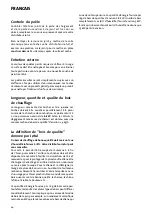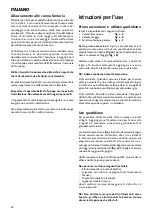
18
External maintenance
Painted products
may, after some years of use, change
colour. The surface should be brushed of loose particles
before new paint is applied.
Enamelled products
have just to be wiped with a dry cloth.
Don’t use soap and water. Eventual spots can be removed
with a cleaning liquids.
Woodlength, quantity and quality
Max. length of the wood logs are
40 cm
. The wood logs
should be laid parallel to the back wall of the stove. Jøtul F
3
has with its efficiency a heat output of nominal capacity of
6 kW
. According to calculations the maximum heat output
will consume 2,4 kg quality-wood per hour.
Jøtuls definition of quality-wood
Good quality-wood should be dried so that the water
content is approx. 20-25%. To achieve that, the wood should
be cut late winter, or early in the spring and dried in the
open air during the summer. In Autumn take the wood
logs inside for use during the coming winter.
By quality wood, we mean most well-known types of wood
such as: Beech, Birch and Oak.
The energy mass of 1 kg of wood varies very little. On the
other hand the net weight of the different kinds of wood
varies considerably. I. e. the weight of a certain amount of
birch will give less kWh than the same amount of beech.
The energy mass of 1 kg quality wood is about
3
,8 kWh. 1
kg of absolute dry wood produces about 5 kWh and wood
of 60 % humidity gives only about 1,5 kWh.
Service
Replacing the Air Chamber and Burn
Plates
It is not uncommon for baffle and burn plates to need
replacement after years of use. Whether they need to be
replaced, and with what frequency, depends on how the
stove has been used.
Replacing the Air Chamber
Remove the door to avoid any damages to the glass or
enamel.
In the case of side/rear connection, the following should
be done:
• Disconnect the top plate of Jøtul F
3
. This is connected
to the side plates with 2 collar head screws - one on
each side. See
fig. 3
.
• Remove these with the Allen key which are supplied
with the stove.
• Pull aside the flips at the top of the heat shield at the
back (2 of them)
(fig. 4 B)
. It will then be possible to
use a screw driver to keep in place the screw which is
situated there.
• Unscrew the nuts under the air chamber at the back
edge (towards the back wall), one on each side
(fig.
7)
.
• The air chamber is fastened at the front to the side burn
plates with the screws
(fig. 8)
. These are loosened and
the air chamber can then be lifted out from above.
In the case of top connection, the following should be
done:
Lift out the ash moulding (the log stopper). The air chamber
is lifted out through the door opening with one hand, while
at the same time flipping in and pulling out the one of the
side burn plates. The air chamber may now be lowered
diagonally and twisted out via the door opening.
Assembly of a new air chamber
Follow the same procedure in reverse order.
Changing the burn plates/inner base
plate
Follow the same procedure as for:
Changing the air
chamber.
Defected parts can be removed and replaced once
everything is loosened. First remove the side burn plates,
then the back burn plate. Finally, the inner base plate is
then removed. If the parts get somewhat stuck, use a
large screwdriver or something similar to flip them loose.
When assembling, the same procedure is followed in
reverse order.
englIsh
Summary of Contents for 3 USA
Page 2: ... ...
Page 51: ...51 ...
Page 52: ...52 Fig 8 Fig 7 Fig Fig 5 Fig 4 Fig 3 Fig 2 B A Fig 9 A B D C ...
Page 53: ...53 ...
Page 54: ...54 ...
















































